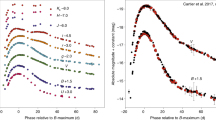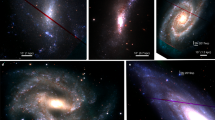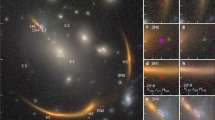Abstract
The ultimate fate of the Universe, infinite expansion or a big crunch, can be determined by using the redshifts and distances of very distant supernovae to monitor changes in the expansion rate. We can now find1 large numbers of these distant supernovae, and measure their redshifts and apparent brightnesses; moreover, recent studies of nearby type Ia supernovae have shown how to determine their intrinsic luminosities2,3,4—and therefore with their apparent brightnesses obtain their distances. The >50 distant supernovae discovered so far provide a record of changes in the expansion rate over the past several billion years5,6,7. However, it is necessary to extend this expansion history still farther away (hence further back in time) in order to begin to distinguish the causes of the expansion-rate changes—such as the slowing caused by the gravitational attraction of the Universe's mass density, and the possibly counteracting effect of the cosmological constant8. Here we report the most distant spectroscopically confirmed supernova. Spectra and photometry from the largest telescopes on the ground and in space show that this ancient supernova is strikingly similar to nearby, recent type Ia supernovae. When combined with previous measurements of nearer supernovae2,5, these new measurements suggest that we may live in a low-mass-density universe.
This is a preview of subscription content, access via your institution
Access options
Subscribe to this journal
Receive 51 print issues and online access
$199.00 per year
only $3.90 per issue
Buy this article
- Purchase on Springer Link
- Instant access to full article PDF
Prices may be subject to local taxes which are calculated during checkout




Similar content being viewed by others
References
Perlmutter, S. et al. in Thermonuclear Supernovae (eds Ruiz-Lapuente, P. et al.) 749–763 (Kluwer, Dordrecht, ( 1997)).
Phillips, M. M. The absolute magnitudes of Type Ia supernovae. Astrophys. J. 413, L105–L108 (1993).
Hamuy, M. et al. The absolute luminosities of the Calán/Tololo Type Ia supernovae. Astron. J. 112, 2391– 2397 (1996).
Riess, A. G., Press, W. H. & Kirshner, R. P. Using Type Ia supernova light curve shapes to measure the Hubble constant. Astrophys. J. 438, L17–L20 (1995).
Perlmutter, S. et al. Measurements of the cosmological parameters Ω and Λ from the first seven supernovae at z ⩾ 0.35. Astrophys. J. 483, 565–581 ( 1997).
Perlmutter, S. et al. IAU Circ.No. 6621 ((1997)).
Schmidt, B. et al. IAU Circ.No. 6646 ((1997)).
Goobar, A. & Perlmutter, S. Feasibility of measuring the cosmological constant Λ and mass density Ω using Type Ia supernovae. Astrophys. J. 450, 14– 18 (1995).
Riess, A. G. et al. Time dilation from spectral feature age measurements of Type Ia supernovae. Astron. J. 114, 722– 729 (1997).
Nugent, P. et al. Evidence for a spectroscopic sequence among Type Ia supernovae. Astrophys. J. 455, L147– L150 (1993).
Goldhaber, G. et al. in Thermonuclear Supernovae (eds Ruiz-Lapuente, P. et al.) 777–784 (Kluwer, Dordrecht, ( 1997)).
Leibundgut, B. et al. Time dilation in the light curve of the distant Type Ia supernova SN 1995K. Astrophys. J. 466, L21– L44 (1996).
Bessell, M. S. UBVRI passbands. Publ. Astron. Soc. Pacif. 102, 1181–1199 (1990).
Branch, D., Nugent, P. & Fisher, A. in Thermonuclear Supernovae (eds Ruiz-Lapuente, P. et al.) 715–734 (Kluwer, Dordrecht, (1997)).
Burstein, D. & Heiles, C. Reddenings derived from H I and galaxy counts—accuracy and maps. Astron. J. 87, 1165–1189 (1982).
Perlmutter, S. et al. IAU Circ.No. 6540 ((1997)).
Leibundgut, B. et al. Premaximum observations of the type Ia SN 1990N. Astrophys. J. 371, L23–L26 (1991).
Wells, L. A. et al. The type Ia supernova 1989B in NGC 3627 (M66). Astron. J. 108, 2233–2250 (1994).
Branch, D. et al. The type I supernova 1981b in NGC 4536: the first 100 days. Astrophys. J. 270, 123– 139 (1983).
Patat, F. et al. The Type Ia supernova 1994D in NGC 4526: the early phases. Mon. Not. R. Astron. Soc. 278, 111– 124 (1996).
Cappellaro, E., Turatto, M. & Fernley, J. in IUE—ULDA Access Guide No. 6: Supernovae (eds Cappellaro, E., Turatto, M. & Fernley, J.) 1– 180 (ESA, Noordwijk, (1995)).
Leibundgut, B., Tammann, G., Cadonau, R. & Cerrito, D. Supernova studies. VII. An atlas of light curves of supernovae type I. Astron. Astrophys. Suppl. Ser. 89, 537– 579 (1991).
Holtzman, J. et al. The photometric performance and calibration of WFPC2. Publ. Astron. Soc. Pacif. 107, 1065– 1093 (1995).
Whitmore, B. & Heyer, I. New Results on Charge Transfer Efficiency and Constraints on Flat-Field Accuracy (Instrument Sci. Rep. WFPC2 97-08, Space Telescope Science Institute, Baltimore, (1997)).
Kim, A., Goobar, A. & Perlmutter, S. Ageneralized K-corrections for Type Ia supernovae: comparing R-band photometry beyond z = 0.2 with B, V, and R-band nearby photometry. Publ. Astron. Soc. Pacif. 108, 190– 201 (1996).
Stiavelli, M. & Mutchler, M. WFPC2 Electronics Verification (Instrument Sci. Rep. WFPC2 97-07, Space Telescope Science Institute, Baltimore, (1997)).
Carrol, S., Press, W. & Turner, E. The cosmological constant. Annu. Rev. Astron. Astrophys. 30, 499–542 ( 1992).
Schramm, D. in Astrophysical Ages and Dating Methods (eds Vangioni-Flam, E. et al.) 365–384 (Editions Frontières, Gif sur Yvette, (1990)).
Acknowledgements
The authors are members of the Supernova Cosmology Project. We thank CTIO, Keck, HST, WIYN, ESO and the ORM–La Palma observatories for a generous allocation of time, and the support of dedicated staff in pursuit of this project; D. Harmer, P. Smith and D. Willmarth for their help as WIYN queue observers; and G. Bernstein and A. Tyson for developing and supporting the Big Throughput Camera which was instrumental in the discovery of this supernova.
Author information
Authors and Affiliations
Corresponding author
Additional information
Physics Department, Stockholm University, Box 6730, S-11385 Stockholm, Sweden
Rights and permissions
About this article
Cite this article
Perlmutter, S., Aldering, G., Valle, M. et al. Discovery of a supernova explosion at half the age of the Universe. Nature 391, 51–54 (1998). https://doi.org/10.1038/34124
Received:
Accepted:
Published:
Issue Date:
DOI: https://doi.org/10.1038/34124
This article is cited by
-
Constraints on the emergent universe from recent temperature and Hubble data
Astrophysics and Space Science (2024)
-
Accelerating plane symmetric cosmological model with bulk viscous and cosmic strings in Lyra’s geometry
Indian Journal of Physics (2024)
-
Stability analysis of anisotropic Bianchi type I cosmological model
Afrika Matematika (2024)
-
Domain wall with quark matters cosmological models in f(R,T) theory
Indian Journal of Physics (2024)
-
Recent acceleration and future deceleration in Brans–Dicke theory
General Relativity and Gravitation (2024)
Comments
By submitting a comment you agree to abide by our Terms and Community Guidelines. If you find something abusive or that does not comply with our terms or guidelines please flag it as inappropriate.



